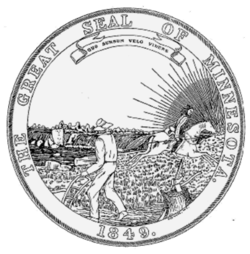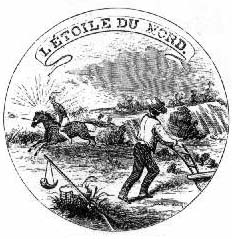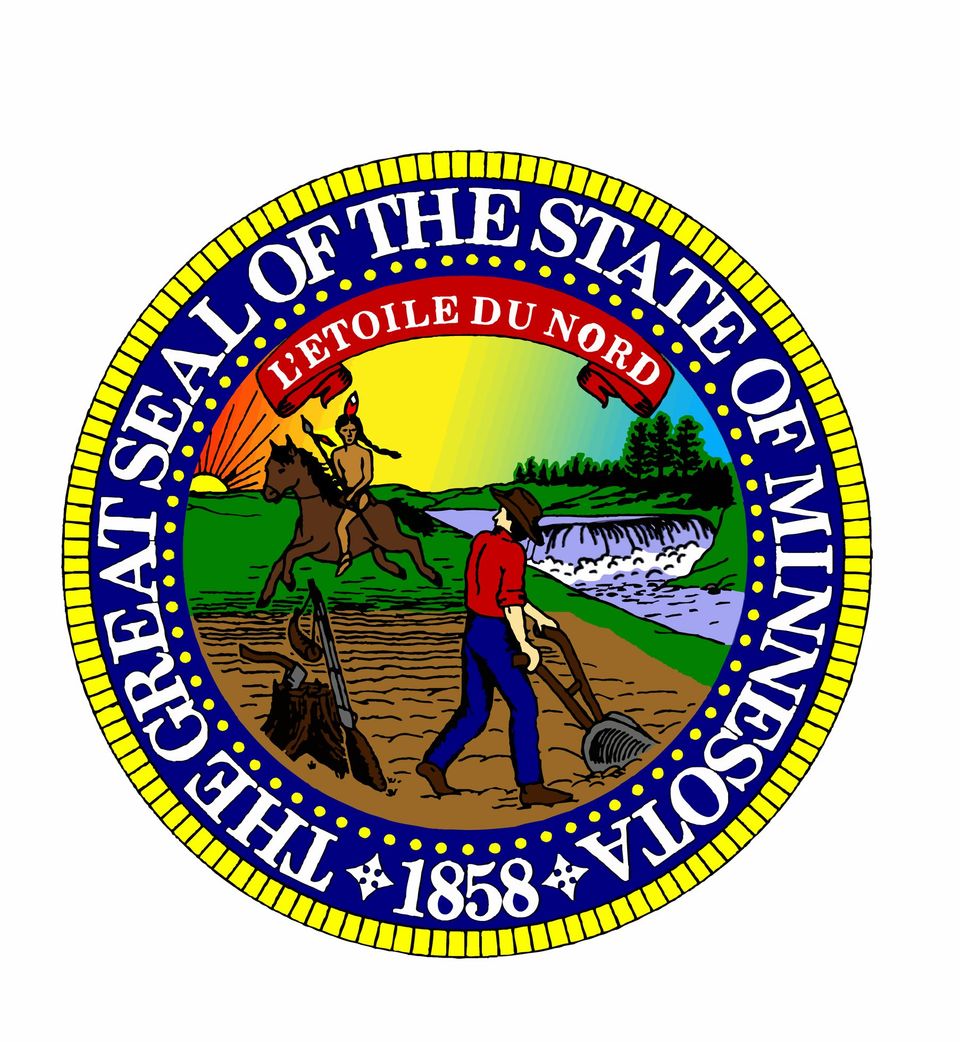The Great Seal of MN
The Territorial and State Seals of Minnesota
The Great Seal of Minnesota Territory
In 1849, Henry Sibley proposed a sketch drawn by Seth Eastman as the basis for Minnesota's Territorial Seal. It pictured a barefoot farmer working in a field near the falls of St Anthony on the Mississippi and an Indian riding into what was described as the setting sun (although it was on the right side of the sketch). The legislature agreed. A Latin phrase, "Quae sursum volo videre" (translation: “I wish to see what is beyond”) was intended to be the Territory's motto. Unfortunately, when the seal was engraved the phrase was misspelled. "Quo sursum velo videre" doesn't make much sense in Latin, but is most closely translated as "I cover to see what is above."
Eastman's wife, Mary Henderson Eastman, wrote extensively about the Indian life and culture that her husband captured in his sketchpad. Her perspective reflected the widely held view that the inferior Indian culture was being replaced by a superior European one. These views, accepted as proper and correct in the mid- to late- 1800's, would cause concern about the symbolism of the seal in the mid-1900's.
The Great Seal of Minnesota State
Minnesota was admitted to the union on May 11, 1858 and two weeks later the first secretary of state, Frances Baasen, wrote to Governor Henry Sibley, "My office being without a Seal, I can do no official act...." Governor Sibley immediately authorized the continued use of the territorial seal until a new state seal could be engraved.
The state constitution required that all official documents be stamped with the official seal of the state, and the legislature accepted submissions for design of the seal in 1857. Two designs were given serious consideration, and a bill accepting one of them was introduced in the then territorial legislature in January of 1858. No action was taken until June of 1858, when the state legislature adopted a design submitted by Robert Sweeney, an artistically talented druggist in St Paul. The adoption of his design for the seal was, however, never signed into law. A resolution authorizing the governor to have the seal engraved does appear in the legislative record for the year.
Henry Sibley had suggested the design of the territorial seal in 1849, and it is not surprising that he ignored the design authorized by the legislature and had a slightly modified territorial seal cast as the Great Seal of the State of Minnesota. The sketch was modified so that the Indian rides into the setting sun from right to left while the farmer plows from left to right. The French motto, "L'Etoile du Nord" (Star of the North) replaced the Latin phrase in the banner at the top of the sketch. When it learned of the design, the Legislature was not happy with the Governor's decision in the matter, but the Attorney General ruled that the seal had been made legitimate through its use. In 1861, the state legislature approved the seal as cast by Governor Sibley.
A fire destroyed the capital in 1881. The legislature was in session and its members, along with some area residents, attempted to save the valuable documents and artifacts housed there. The seal was removed from the vault in which it was kept and brought out of the burning building but, in the chaos of the moment, was dropped on the street. A Dutch businessman, Peter Bergsma, did not realize at first that a bronze object he picked up near the corner of College and Wabasha streets was the state seal. He brought it back to Europe with him where it sat upon his desk. After Bergsma moved to England, he began to think he should return the seal to Minnesota. In 1881, Mr. and Mrs. William Dyer of St. Paul visited Bergsma at his home in Torquay, England. He entrusted the seal to them. When the couple returned to St. Paul, Mr. Dyer delivered the original state seal to Governor S. R. Van Sandt. A new seal had been engraved immediately after the fire, so on October 18, 1901, this precious artifact was donated to the Minnesota Historical Society.
In the 1960's, concerns were raised that the original design for the seal denigrated the Indian nations of Minnesota, so a new seal was forged that replaced the Indian on horseback with a white settler.
In 1971, the seal was no longer required on many official state documents.
In 1983 the legislature restored the Indian and provided this explanation of the seal's symbolism:
"The sun, visible on the western horizon, signifies summer in the northern hemisphere. The horizon's visibility signifies the flat plains covering much of Minnesota. The Indian on horseback is riding due south and represents the great Indian heritage of Minnesota. The Indian's horse and spear and the Pioneer's ax, rifle, and plow represent tools that were used for hunting and labor. The stump symbolizes the importance of the lumber industry in Minnesota's history. The Mississippi River and St. Anthony Falls are depicted to note the importance of these resources in transportation and industry. The cultivated ground and the plow symbolize the importance of agriculture in Minnesota. Beyond the falls three pine trees represent the state tree and the three great pine regions of Minnesota; the St. Croix, Mississippi, and Lake Superior."


